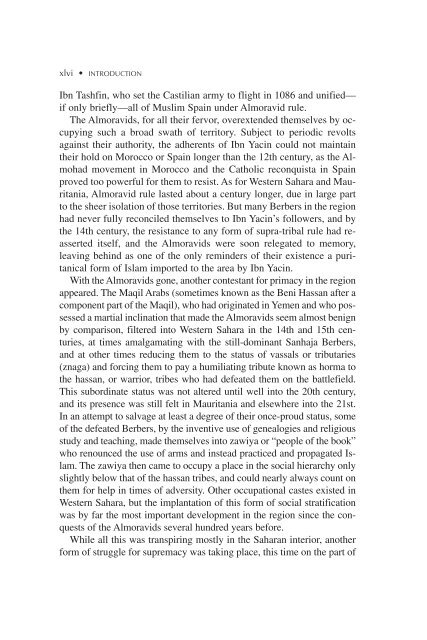Historical Dictionary of Western Sahara Third ... - Scarecrow Press
Historical Dictionary of Western Sahara Third ... - Scarecrow Press
Historical Dictionary of Western Sahara Third ... - Scarecrow Press
Create successful ePaper yourself
Turn your PDF publications into a flip-book with our unique Google optimized e-Paper software.
xlvi • INTRODUCTION<br />
Ibn Tashfin, who set the Castilian army to flight in 1086 and unified—<br />
if only briefly—all <strong>of</strong> Muslim Spain under Almoravid rule.<br />
The Almoravids, for all their fervor, overextended themselves by occupying<br />
such a broad swath <strong>of</strong> territory. Subject to periodic revolts<br />
against their authority, the adherents <strong>of</strong> Ibn Yacin could not maintain<br />
their hold on Morocco or Spain longer than the 12th century, as the Almohad<br />
movement in Morocco and the Catholic reconquista in Spain<br />
proved too powerful for them to resist. As for <strong>Western</strong> <strong>Sahara</strong> and Mauritania,<br />
Almoravid rule lasted about a century longer, due in large part<br />
to the sheer isolation <strong>of</strong> those territories. But many Berbers in the region<br />
had never fully reconciled themselves to Ibn Yacin’s followers, and by<br />
the 14th century, the resistance to any form <strong>of</strong> supra-tribal rule had reasserted<br />
itself, and the Almoravids were soon relegated to memory,<br />
leaving behind as one <strong>of</strong> the only reminders <strong>of</strong> their existence a puritanical<br />
form <strong>of</strong> Islam imported to the area by Ibn Yacin.<br />
With the Almoravids gone, another contestant for primacy in the region<br />
appeared. The Maqil Arabs (sometimes known as the Beni Hassan after a<br />
component part <strong>of</strong> the Maqil), who had originated in Yemen and who possessed<br />
a martial inclination that made the Almoravids seem almost benign<br />
by comparison, filtered into <strong>Western</strong> <strong>Sahara</strong> in the 14th and 15th centuries,<br />
at times amalgamating with the still-dominant Sanhaja Berbers,<br />
and at other times reducing them to the status <strong>of</strong> vassals or tributaries<br />
(znaga) and forcing them to pay a humiliating tribute known as horma to<br />
the hassan, or warrior, tribes who had defeated them on the battlefield.<br />
This subordinate status was not altered until well into the 20th century,<br />
and its presence was still felt in Mauritania and elsewhere into the 21st.<br />
In an attempt to salvage at least a degree <strong>of</strong> their once-proud status, some<br />
<strong>of</strong> the defeated Berbers, by the inventive use <strong>of</strong> genealogies and religious<br />
study and teaching, made themselves into zawiya or “people <strong>of</strong> the book”<br />
who renounced the use <strong>of</strong> arms and instead practiced and propagated Islam.<br />
The zawiya then came to occupy a place in the social hierarchy only<br />
slightly below that <strong>of</strong> the hassan tribes, and could nearly always count on<br />
them for help in times <strong>of</strong> adversity. Other occupational castes existed in<br />
<strong>Western</strong> <strong>Sahara</strong>, but the implantation <strong>of</strong> this form <strong>of</strong> social stratification<br />
was by far the most important development in the region since the conquests<br />
<strong>of</strong> the Almoravids several hundred years before.<br />
While all this was transpiring mostly in the <strong>Sahara</strong>n interior, another<br />
form <strong>of</strong> struggle for supremacy was taking place, this time on the part <strong>of</strong>
















